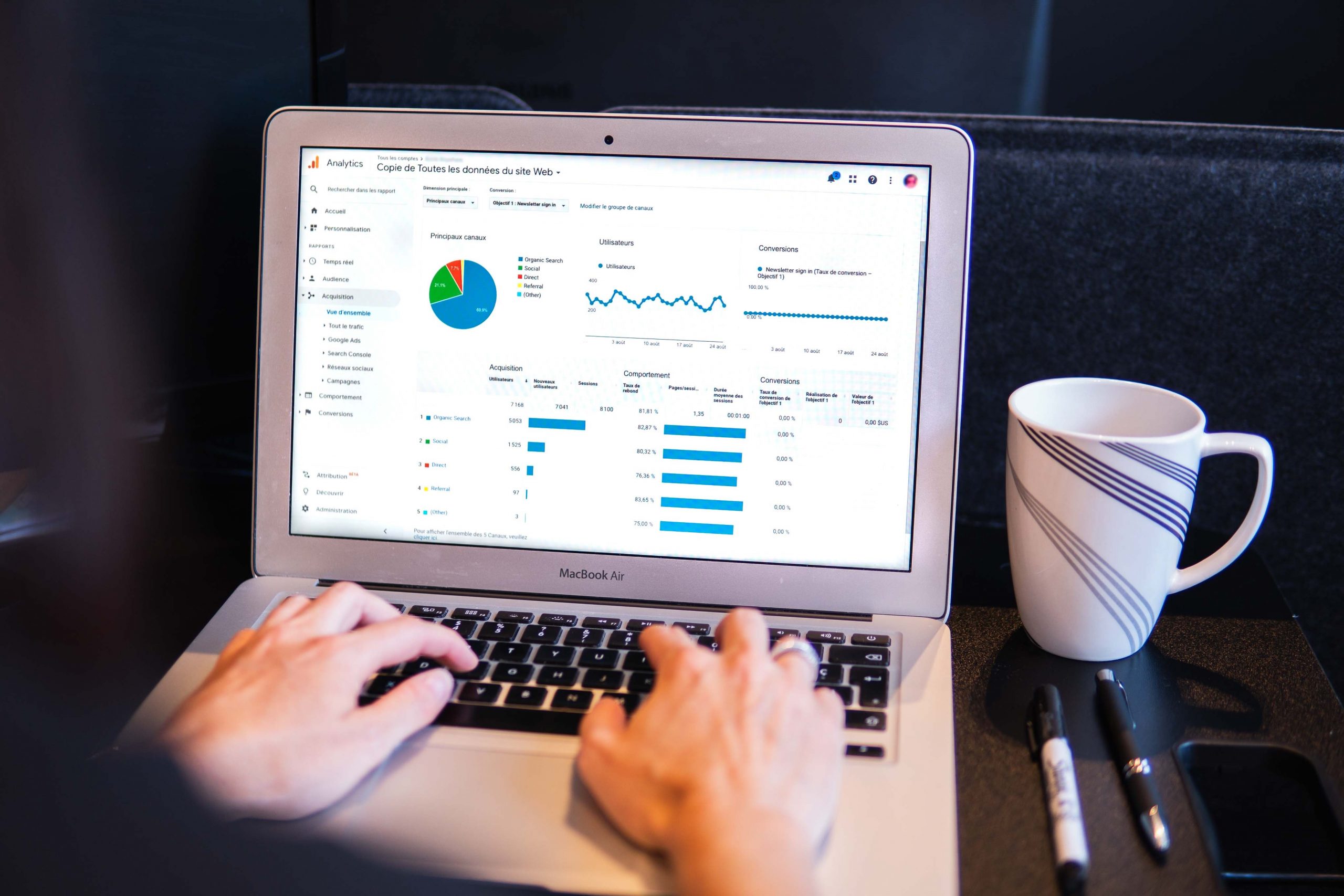Whether you’re a Google Ads newbie just getting started or a seasoned professional looking for advice on how to boost the performance of your existing campaigns, we have some tips and tricks from the experts at 565 Media on how to take advantage of Google’s Smart Bidding algorithms and optimally scale your PPC campaigns to profitability.
What is Smart Bidding?
Smart Bidding is a series of automated bidding strategies available for advertisers on the Google Ads platform. According to Google, the strategies utilize machine-learning algorithms to help optimize performance for a selected goal. Advertisers can select bidding strategies that maximize conversions, optimize cost per acquisition, target a specific return-on-ad-spend, and more.
Advantages of Smart Bidding
- Utilizes true auction-time bidding – Google’s machine learning identifies users that are most likely to complete a target conversion and adjusts the bidding for every single auction to optimize your budget for that conversion.
- Wide range of contextual signals – Metrics such as time of day, device, operating system, location, language, demographics are cross-analyzed for richer user targeting.
- Advanced optimization capabilities – Google’s machine learning can result in more precise bids and optimize your campaigns beyond what’s possible with manual options.
- Saves time – With the right settings and strategy up front, advertisers can save hours (even days!) of manual bidding adjustments and PPC management.
Disadvantages of Smart Bidding
- Less Manual Control – Bidding adjustments based on device, time of day, demographics, etc. don’t have any effect when using smart bidding strategies. Even if you know your target audience well, you’ll have to let the algorithm learn that on its own.
- Long “Learning” Period – Smart bidding algorithms typically require about a week to complete the learning period, but this will vary depending on the available conversion data.
- Potential for Increased Costs – Google Ads runs on auctions for bidding. If more competitors begin relying on smart bidding to target the same user base, the automated bidding strategies will inflate the prices as they try to outbid each other.
Maximize Conversions Bidding Strategy
The Maximize Conversions bidding strategy allows advertisers to maximize the total number of conversions with their set daily budget. This strategy can be used for search ads, display ads, Discovery campaigns, and YouTube for Action ads.
This bidding strategy is best used when you have conversions that do not have a specific value or if you do not have a specific CPA or ROAS goal for your campaign. We recommend using this strategy if your campaign has a low conversion volume or if you have a limited budget and under 90% impression share. This strategy also allows you to identify a baseline for a Target CPA (tCPA) strategy in the future.
Maximize Conversion Value Bidding Strategy
The Maximize Conversion Value bidding strategy allows advertisers to maximize the overall value of conversions with their set daily budget. This strategy can be used for search ads, display ads, Discovery campaigns, and YouTube for Action ads.
The bidding strategy is best used when you have specified and varying conversion values for all of your campaign goals, but do not have a specific CPA or ROAS target. This strategy is useful for ecommerce sites that may have very high or very low conversion values to consider, because the machine-learning algorithm will optimize for higher value conversions. This strategy also allows you to identify a baseline for a Target CPA (tCPA) strategy in the future.
Target CPA Bidding Strategy
Target CPA Bidding, or tCPA, refers to “cost per acquisition” and allows advertisers to set an average target cost for each conversion that the campaign receives. This strategy can be used for either search ads or display ads.
This bidding strategy only works if you have established a conversion value for each type of goal conversion that you are using in the campaign. We recommend using this strategy if you need to limit your ad spend for a specific CPA. This typically works best for businesses that rely on lead generation or for eCommerce businesses.
The strategy also only works if your conversion values are large enough to cover reach that target CPA. (That means setting a $0.01 Target CPA is unlikely to provide fruitful results.)
How do I calculate my Target CPA bid?
Finding the right initial target for your Target CPA settings is a tricky feat. A lower Target CPA will result in more conversions but more waste. A higher Target CPA will result in fewer conversions and better cost efficiency.
To calculate an initial Target CPA bid, you’ll need to factor in multiple considerations. How much average revenue is gained from a single conversion? How much does it cost to produce your product or service? What are the additional non-marketing costs involved? What is the gross profit and your desired net profit?
The basic equation should look something like this:
Gross Profit - Desired Net Profit = Target CPA Average revenue - Costs of Production = Gross Profit
If your campaign has been running under a different bidding strategy for a while, Google will provide you with a recommended Target CPA to start with.
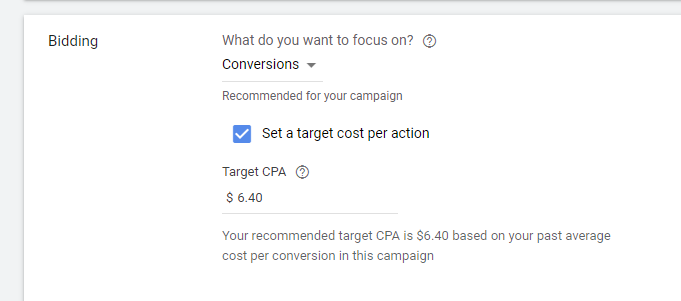
As the smart bidding algorithm learns and optimizes over time, and the campaign is capable of matching your Target CPA, consider increasing your Target CPA by 15% every month until the campaign performance maxes out. If you run your campaign for a month and find that it isn’t able to match your Target CPA, consider reducing your Target CPA by 15% per month until the campaign performance is able to match it.
Another note: There are no conversion minimum thresholds that you will need to meet for this bidding strategy.
Target ROAS Bidding Strategy
Target ROAS Bidding refers to “return on ad spend” and allows advertisers to set a target percentage of conversion value over the amount spent on the ads. This strategy can only be used on search ads.
Similarly to the Target CPA strategy, this bidding strategy only works if you have established a conversion value for each type of goal conversion that you are using in the campaign. We recommend using this strategy if you are tracking multiple goal conversions at differing values, such as eCommerce businesses or businesses that offer different price plans for their services.
How do I calculate my Target ROAS?
To start using this bidding strategy, Google requires an initial Target ROAS. To calculate this value, divide your average conversion value by the average cost of your ad. For example, if you receive $1000 for $10 spent on search ads, your ROAS is 100.
If your campaign has been running under a different bidding strategy for a while, Google may provide you with a recommended Target ROAS or Target CPA to start with.
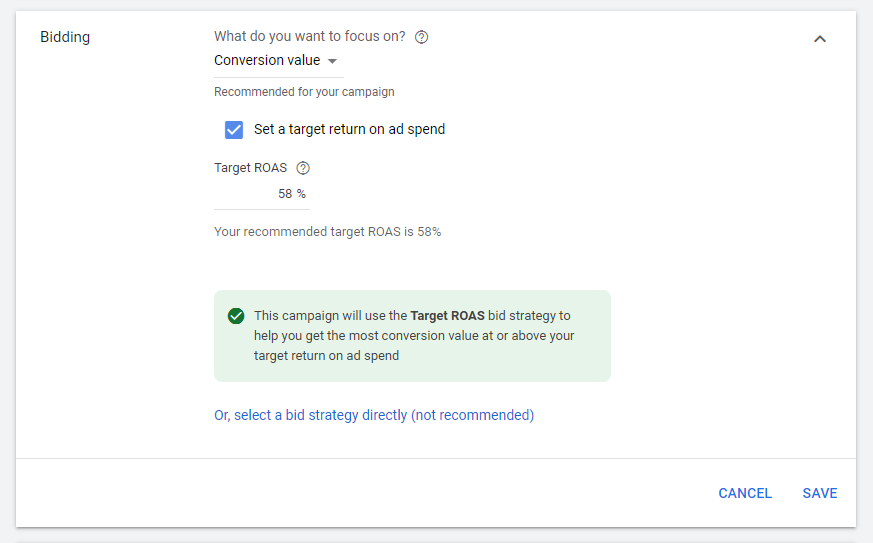
After the smart bidding algorithm learns and optimizes over time, you may be in a situation where you are able to consistently reach a positive Target CPA or Target ROAS. From that point, if it makes sense for your business goals and you would like to scale those successes, consider incremental changes to your target. We recommend increasing your Target ROAS by 15% after each month that the campaign matches the target. Conversely, if that campaign is unable to meet your Target ROAS, consider reducing the limit by 15% each month until you find an equilibrium.
You may have already guessed, but this strategy only works if your conversion values are large enough to cover your target ROAS. (That means setting a 10,000% Target ROAS is unlikely to be successful.)
Another note: In order to use the Target ROAS bidding strategy, Google requires at least 15 conversions per month.
Other Considerations
The most important thing to consider when deciding on changing your target bids is your overall marketing goal. If you are looking for efficiency in your budget, Target ROAS will allow you to spend your ad budget effectively. However, this method does not necessarily work for businesses aimed at growth. If you are looking to grow your business, less “efficient” budgeting strategies like Maximize Conversions will allow you to reach a larger pool of potential customers.
Other Types of Bidding Strategies
Maximize Clicks
Maximize Clicks Bidding allows you to get as many clicks as possible with your daily budget. This functionality will set keyword bidding automatically to optimize the number of clicks that a campaign gets. This is useful if your campaign does not yet have defined conversions.
One of the drawbacks to this type of bidding strategy is that the Google algorithm does not necessarily know which keywords have the strongest conversion intent. So you may reduce your average CPC overall, but the quality of the leads will depend on your keyword curation abilities.
Target Impression Share
Target Impression Share Bidding allows you to set bids to show your ad at the top of the page. Using this functionality, you can set a percentage of how often you want your ads to appear at the top of the page. Google also allows advertisers to specify if they would like to target the very first spot or any ad positions at the top of the page. From there, the bidding strategy takes over and will charge you the minimum spend required to place your ads where you like.
This is not a smart bidding strategy, so many of the advantages and disadvantages listed above will not apply to Target Impression Share.
When using the Target Impression Share bidding strategy, you will be able to specify where on the search results page your ads will appear –anywhere on the first page, anywhere at the top of the page, or only in the top placement.
From there, you can specify how often you want your ads to appear in that position. The ability of your campaign to match this number will depend on the keywords that you are targeting and your daily spending limit.
You can also specify the maximum amount that you are willing to bid on any individual auction. This will help limit situations where you get into a bidding war with a competitor over a single keyword.
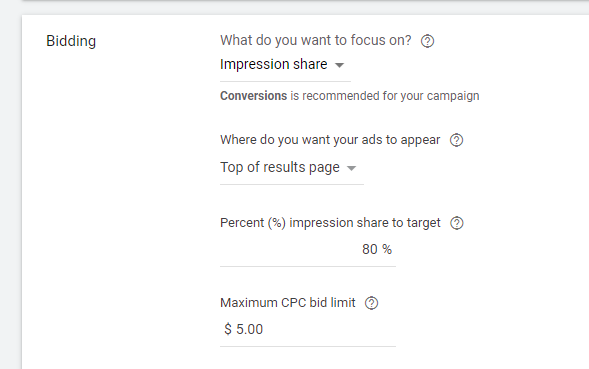
Best Practices for Smart Bidding
Apply smart creative solutions
Over 75% of the impact of advertising on the Google Ads platform is determined by the quality of the creative. Even if your bidding strategy and settings are perfectly optimized, if your creative isn’t up to par, you’re unlikely to see the best results.
Luckily, we can include the machine-learning algorithm in the ad creative process as well.
Google Search Ads now offer Responsive search ads (RSAs), which will test out combinations of multiple headlines and description text to identify the best performing search ad creative over time.
Google Display Ads offer Responsive display ads (RDAs), which similarly automate the process of testing different images, headlines, description text and ad dimensions, and give advertisers a live report on which combinations perform the best.
For both responsive search ads and responsive display ads, we recommend running one in each ad group for at least a month. Then, manually create search and display ads from the best performing combinations. From there, you can safely make edits to the responsive ads to test out new combinations in the future.
Implement a non-last-click attribution model
As most advertisers know, the customer journey down the sales funnel isn’t always a straight line. Some goal conversions have a wide conversion window. Some have more than 10 interactions before a successful conversion.
For the Smart Bidding algorithm to get a better understanding of the customer journey and optimize your campaign settings, it is best to use an attribution model that gives more credit to the different steps along the way to a successful conversion.
Last-click attribution modeling, for example, gives all of the credit for a successful conversion to the last-clicked ad and corresponding keyword. This setting will
We recommend using the Time Decay or Data-driven attribution models when using Smart Bidding. These settings will assign credit based on the actual contribution of each keyword and ad across the customer journey to a successful conversion, and will learn and adjust that credit over time based on the performance data that your campaign collects.
Add audience lists at the account level
Smart Bidding works best when it has more data. When you set audience lists at the account level, it allows each campaign to access the performance data set for the entire account rather than just that campaign.
With this setting, the Smart Bidding algorithm will be able to utilize richer user signals, such as intent, context, and recency. This allows for better overall performance and saves time in the “learning “ process.
If you would like to target only new users and want to avoid showing your ads to customers that have already purchased something on your website, we recommend adding the “All Converters” audience list to your campaign and add a -100% bidding adjustment.
Getting Started with Smart Bidding
As we outlined above, many smart bidding strategies rely on past performance data to help the machine learning algorithm learn and optimize a campaign’s settings. But for advertisers that are starting with a brand new account, we have a few recommendations on how to get started.
- Add conversion tracking – Before any kind of smart bidding strategies can be implemented, you’ll need to make sure that your conversion tracking is in place and working correctly.
- Soft launch with manual bidding – Make sure that your settings are in order before relying entirely on Smart Bidding to do the work for you. Launch your campaign with Enhanced CPC on a constrained budget for a month and check on your performance metrics to make sure that your keyword targeting, ad creative, ad extensions, and conversions are working correctly. The extra time that you give the campaign under these settings will also help build historical performance data for the machine learning algorithm to use when you switch over to Smart Bidding.
- Switch to the right Smart Bidding setting – Once your campaign is running smoothly and it’s time to scale up, select the Smart Bidding strategy that works best for your goals. If you do not have specific values attached to your goal conversions, use the Maximize Conversions strategy. If you have a specific CPA goal, use the Target CPA strategy. If you have conversion values added but don’t have a specific ROAS goal, use the Maximize Conversion Value strategy. If you do, use the Target ROAS strategy.
- Optimize every 30 days – As your campaign matures and the Smart Bidding algorithms learn how to optimize your performance, consider adjusting your CPA or ROAS targets gradually by 15% increases at a time.
Frequently Asked Questions
How long does the Learning Period last?
It typically takes one to two weeks for the algorithm to collect enough performance data to calibrate a newly implemented bidding strategy. This depends on the amount of conversion data that the campaign is able to collect.
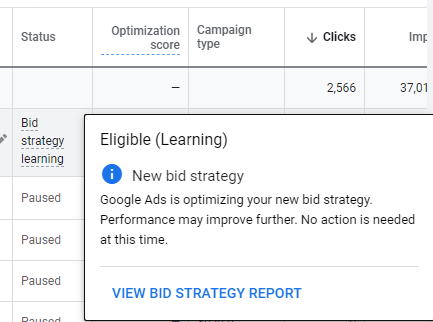
If your campaign generates many conversions very quickly, it will likely exit the learning phase quickly as well. As a rule of thumb, you should aim to generate a minimum of 30 conversions per month. If your campaign generates conversions slowly, it will likely extend the length of the learning phase.
If your campaign does not generate any conversions at all, you have a much bigger problem than configuring your Smart Bidding strategy, and should consider troubleshooting your target keywords, ad creative, and conversion settings under a manual bidding strategy like eCPC before moving onto Smart Bidding.
How do I calculate the appropriate time lag for conversions?
Depending on the business that you are running, some goal conversions may have a wide window between the first impression and a successful conversion.
To identify the average time lag for your search campaigns, visit the Search Attribution report. Set a 30-day window, and the report will show you the number of days that it takes, either from first impression or first click, to result in a conversion. Below each number of days, the report will indicate the percentage of users that have completed a conversion.
To identity the average time lag for your display campaigns, set a 90-day window and segment your campaign-level conversion data by “days to conversions”. This chart will provide the average conversion lag for display ads.
Troubleshooting Common Problems with Smart Bidding Strategies
- Target CPA or ROAS goal is unrealistic – If you are too aggressive with your initial target bids, the algorithm will learn that it cannot meet your target CPA or target ROAS and may stop running ads.
- Not enough time to complete the learning period – The machine learning algorithm needs long term data points to form better predictions for performance. If you look at a few days worth of data and start making changes based on a small sample size, the algorithm will not be able to optimize for conversions or conversion value.
- Not accounting for long conversion delays over time – Many conversions have a window of 30 days or more from first touch to last touch. The first few days of implementing Smart Bidding may seem like it is performing poorly if you do not allow for a time buffer to account for conversion delays.
- Not enough ad budget to find new conversions – If the campaign is constrained by a small budget, the algorithm won’t be able to bid appropriately to find as many conversions as possible.
Feeling Inspired?
Do you want to know more about our Google Ads management services at 565 Media? Have questions about search ads marketing or digital strategy in general? Don’t hesitate to contact us or call (323) 902-7439. Our experts will come up with optimized ad campaigns tailored for your business.
If you’re looking to effectively and efficiently boost ROI with your marketing budget, 565 Media is your top choice. Simply connect with our on-demand team of full stack developers and start with a list of what problems you need solved. Our team specializes in developing customized, scaled marketing campaigns geared towards generating profitable leads and growing your business.


